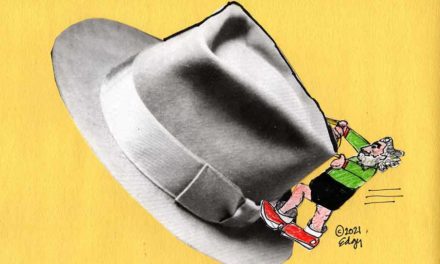Yesterday’s Newseum
By Ed Goldman
When the Washington, D.C. Newseum closed at the end of 2019, I mourned the loss not only of the place but also my last stab at immortality. I still harbored the notion that if I just kept at this media game another few years, one day I’d become an exhibit.
Oh, I didn’t envision anything elaborate—maybe just a small kiosk in the gift shop featuring my best-selling books (books to date: five; best-sellers: zilch). Or maybe a tiny replica of the apartment in New York where I spent my first eight years (“tiny” in this case could be used interchangeably with “life-sized”).
Or why not an endless-loop video of some of my appearances as a collector and painter on our PBS affiliate’s annual art auction (“Now this one is very nicely framed”)?
I loved the Newseum but will admit that I visited it only once and that even though my companion would have spent days there, I grew a little bored after about three hours. Our different reactions had nothing to do with the quality, breadth nor execution of the exhibits. It was because my companion—oh, let’s stop being coy, she was my wife at the time—had never spent any time as a journalist, and was therefore stepping into an unfamiliar world. In contrast, I had become a reporter at the age of 19, owing to an intern-scholarship I received upon transferring from Long Beach City College to California State University, Long Beach.
By the way, I firmly believe I was given this award to ensure I’d leave the junior college, whose president and I came close to engaging in fisticuffs in his office when, in my capacity as editor of the school’s weekly Viking newspaper, I wrote an editorial suggesting the legalization of marijuana.
Anyway the award landed me a job at the daily Long Beach Independent, Press-Telegram, an amalgam of three newspapers’ names (it dropped “Independent” some years ago but is still published daily). To me, it was a dream job, almost literally: Since touring the paper’s once vast offices in a multi-floored building on a school tour when I was in fifth grade, I had made up my mind that someday I’d return as a reporter. As a kid, if I saw a TV show set at a newspaper or featuring a journalist—CBS-TV’s “The Reporter,” with Harry Guardino as a big-city muckraker, or ABC’s “Hong Kong,” with Rod Taylor as a foreign correspondent, spring to mind—I’d wish myself into the storylines, never forgetting the fact I was 11 years old.
Example: In one imaginary episode, swingin’ bachelor-reporter Glenn Evans—the part played by Taylor, who’d become famous the year before starring as author H.G. Wells in a wonderfully imaginative film of the namesake’s novel, “The Time Machine”—is having trouble finding some diamond smugglers in the then-British colony. He calls his stateside editor who crustily tells him, “I’m surprised I have to remind you that we have a fifth-grader on the payroll in Hong Kong named Ed Goldman. Call him if you want to get some contacts with the underground. Do I have to do everything?!” (In reality, had Rod Taylor-as-Glenn Evans called and not made note of the time difference, I’d probably have been at my Bar Mitzvah lesson at Temple Beth Zion.)
I already had been so immersed in journalistic culture for the majority of my life that by the time I saw its history all laid out for me on several floors at various multi-media displays, I probably could have lip-synced along with the recorded narrations. Not so for my eventual ex-wife, an attorney whose work required very little interaction with reporters; she sincerely said she was “thrilled and humbled” by the place.
So why did it close?
Well, may this may be an overreach, but in the nation’s capital, you can stop into dozens of museums without paying—including the 20 or so Smithsonian facilities, the National Gallery of Art, the U.S. Botanical Garden, the National Air & Space Museum, United States Holocaust Memorial Museum and the National Museum of the American Indian, to name just a few.
Ed Goldman's column appears almost every Monday, Wednesday and Friday. A former daily columnist for the Sacramento Business Journal, as well as monthly columnist for Sacramento Magazine and Comstock’s Business Magazine, he’s the author of five books, two plays and one musical (so far).




